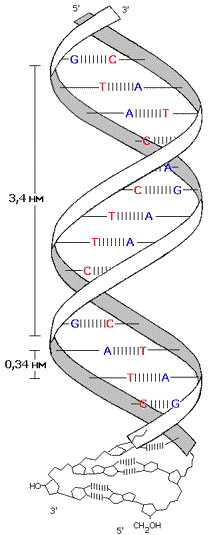
DNA

Deoxyribonucleic acid (DNA) is a
polymer consisting of
nucleotides as
monomers. Primary DNA structure is presented by a nu-cleotide sequence in a non-branched polynu-cleotide chain. It is strictly individual and specific for every natural DNA. It constitutes encoded record of biological information,
genetic code. Every DNA molecule has two polynucleotide chains, which are combined into one double chain. The bases in it are placed in pairs, one opposite another, and joined by
hydrogenous bonds. Two bases can form a pair, only if they are
complementary to each other, that is, "correspond" to each other. The chain is spiraled around the common imaginary centerline, and the bases are disposed perpendicular to this centerline. A double chain of this type is called secondary structure of DNA. Tertiary structure is formed by double chains, connected with proteins by
ionic bonds - for example, in
chromosomes. Before cell division, its DNA doubles, or
replicates, so each new (daughter) cell receives a DNA with the genetic information, identical to that of the initial cell. The sequence of DNA bases determines the order of
amino acid residues in protein molecules. For the genetic information being fulfilled, an RNA chain (which is a copy of a certain section of the DNA) is formed on the base of the coding strand of the DNA by the process of transcription. The sequence of RNA bases serves as a matrix for the synthesis of the protein, the amino acid sequence of which is encoded in the
gene involved.